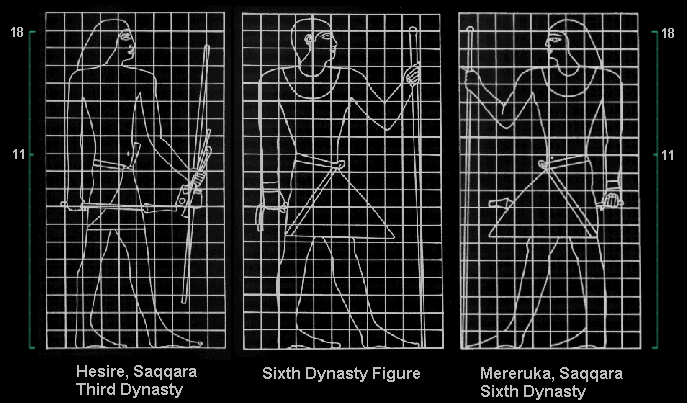
![]()

Whenever the Ancient Egyptian artists sculptured, inscribed or painted figures, their proportions would be determined by a canon of proportions. Up until the end of the New Kingdom's 26th Dynasty, the Ancient Egyptians used a grid that measured 18 units to the hairline, or 19 units to the top of the head. The height of the figure was usually measured to the hairline rather than the top of the head, this part of the head often being concealed by a crown or head piece making it difficult to base a canon of proportions on. 1
This separation of the crown of the skull from the rest of the body reduces the height of the figure to 18 units and provides a consistent point upon which a figure's proportions could be based.
In the Old Kingdom a more simple canon was used, from which the later grid of 18 squares evolved. Also based on the height of the forehead or hairline, this canon had generally six lines, five of which form the basis of, and therefore corresponded to the later 18/19 canon. Occasionally a line level with the top of the head corresponding with the later canon's 19th line was added, though in many Old Kingdom examples this line is omitted."In other words, these horizontals in the (18/19) grid system correspond to (the Old Kingdom) guide lines. Clearly, therefore, the squared grid system in which a standing figure consisted of 18 squares from the soles to the hairline must have developed out of the guide line system. It was able to incorporate all of the earlier lines except those marking the armpits and the crown of the head....The old vertical axial guide line became incorporated as a vertical guide line." 2
This vertical axial line usually passed in front of the ear. In the grid that evolved out of this earlier guideline system, the vertical line immediately in front of this axial line runs through the eye.
This more simple system of horizontal guide lines may have developed into the grid of 18 squares during the Old Kingdom. Grids have been found dating to the third dynasty or possibly earlier. Gay Robins writes:"There is no doubt that grids had already been employed for other purposes in the Old Kingdom....Certainly with the majority of surviving tombs decorated in relief, evidence for the artist's original layout on the wall must have been lost in most cases. By contrast, painted tombs, which were more likely to show evidence of the initial stages of working, have on the whole not been well preserved. So the number of tombs known at the moment to have guidelines is a very small portion of all surviving Old Kingdom tombs. It is possible therefore, that evidence for figures drawn on grids has simply not survived..." 3
In his paper, Rudolf Gantenbrink established that the King's chamber 'air shafts' theoretically meet at a point that is 11/18 of the horizontal distance between the outer openings of the two shafts on the face of the pyramid. He illustrates this with a diagram of the pyramid's cross section in which the shafts are contained in a grid that is 18 squares in width. 4
By laying a hypothetical grid over figures from early dynasties it can be demonstrated that their proportions are identical to those of later dynasties. This would of course be expected if the grid was based upon this earlier system of horizontal lines.

The three figures above have a hypothetical grid of 19 squares overlayed
to show the 18:11 relationship between the height of the hairline and navelIt must be said, however, that the canon of proportions did vary over the thousands of years of Egyptian civilisation. By applying the hypothetical grid of 19 squares to figures from different eras, Gay Robins demonstrates that though different systems were used in different eras, it is possible to speak of what she terms "classic proportions".
These classic proportions began to appear in royal figures of the Third Dynasty and were found almost universally in the Fifth and Sixth dynasties. She adds that draftsman deliberately returned to these proportions from time to time throughout history after periods of political upheaval and artistic change. 5Footnotes:
1. "As Lepsius pointed out, the hairline was used rather than the top of the head presumably because the latter might be obscured
in the case of the king's figure by his various crowns." - Gay Robins, PS, page 73.
2. Gay Robins, Proportion and Style in Ancient Egypt, page 76.
3. Gay Robins, Ibid, page 70.
4. AERSP fig. 10.
5. Gay Robins, Proportion and Style in Ancient Egypt, page 258.
![]()